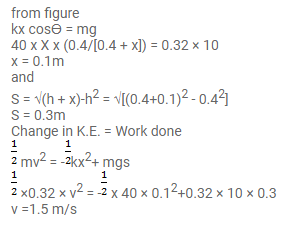Question:
Figure (8-E12) shows two blocks A and B, each having a mass of $320 \mathrm{~g}$ connected by a light string passing over a smooth light pulley. The horizontal surface on which the block A can slide is smooth. The block A is attached to a spring of spring constant $40 \mathrm{~N} / \mathrm{m}$ whose other end is fixed to a support $40 \mathrm{~cm}$ above the horizontal surface. Initially, the spring is vertical and upstretched when the system is released to move. Find the velocity of the block A at the instant it breaks off the surface below it. Take $\mathrm{g}=10 \mathrm{~m} / \mathrm{s}^{2}$.
Solution:

